
The world’s cruellest attractions
News
Travel companies around the world profit from some of the cruellest types of wildlife tourist attractions on earth.
Whether it is riding elephants, taking selfies with tigers, or performing dolphin shows, these activities can cause lifelong suffering for wild animals.
Last year Oxford University’s Wildlife Conservation Research Unit (WildCRU) analysed 24 different types of wildlife attractions across the world. They rated them based on welfare and conservation criteria - we used this information and combined it with our own research to identify 10 of the world’s cruellest types of attractions.
Riding elephants
In order to make elephants submit to elephant rides and other human interactions, they are taken from their mothers when babies and forced through a horrific training process known as ‘the crush’. It involves physical restraints, inflicting severe pain and withholding food and water. By the time tourists come to ride an elephant, it may look at peace, but this is because its spirit has been broken. The bullhook, used permanently, reminds the animal of human dominance.
The cruelty does not end after the crush. When not performing or used for rides most elephants are kept on chains, unable to socially interact with one another. This is hugely damaging to their physical and psychological wellbeing.
Taking tiger selfies
Tiger cubs are separated from their mothers at an early age so they can be used as photo props. They are handled and hugged by tourists and typically kept chained-up, or in small barren cages.
In Thailand we found 17 tiger entertainment venues housing up to 830 tigers. Although cruel tiger tourism venues can be found throughout Thailand, this is a problem around the world.
Our recent report, ‘Tiger selfies exposed: a portrait of Thailand’s tiger entertainment industry’, was released in the run-up to International Tiger Day (June 29 2016). It is the first of its kind, delving below the surface of Thailand’s wildlife tourism industry, and showing just how many tigers suffer when forced to act as props for tourist photos.
Walking with lions
Lion cubs are bred and taken from their mothers typically within a month of birth to supply the growing lion tourism industry, mostly located in Southern Africa. Tourists handle the cubs for hours and pose with them for photos. They are also often told to hit the cubs if they display aggressive or unwelcome behaviour.
When the cubs grow too big for tourists to pick up and hug – but are still young enough to control – they are used for the relatively new walking with lions tourist experience. The lions are trained to ‘safely’ walk with tourists, sometimes on leads.
These lions face a lifetime in captivity as they cannot be released into the wild.
Holding sea turtles
The world’s last remaining sea turtle farm that acts as a tourist attraction is in The Cayman Islands. Here, tourists can hold turtles and even eat them during their visit.
Suffering from stress and disease, sea turtles live a tortured life at the Cayman Turtle Centre. They often panic when they are handled and it has been known for tourists to drop them, causing significant injuries which can kill turtles.
Performing dolphins
Millions of tourists visit dolphinaria, but they are unaware of the cruelty and abuses the dolphins endure to perform in shows.
Whilst it is banned in countries like the US, many performing dolphins around the world are still captured in the wild. They are often chased by high-speed boats before being hauled on board or caught in nets. For many, the stress is too much to take and they die during transportation to their intended destinations.
Whether wild caught or captive bred, dolphins in dolphinaria face a lifetime of suffering. They spend their entire lives in a space not much bigger than a swimming pool – completely unnatural and restrictive compared to their natural open sea environment.
End dolphin suffering
Call on the Queensland government to ban captive dolphin breeding and stop captive dolphins shows and direct interactions.
Animals, not entertainers
Across the globe, animals at wildlife tourism venues are forced to endure intense pain and mostly unseen suffering to entertain tourists and visitors on a daily basis.






